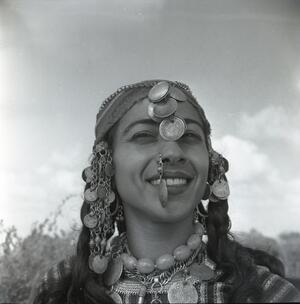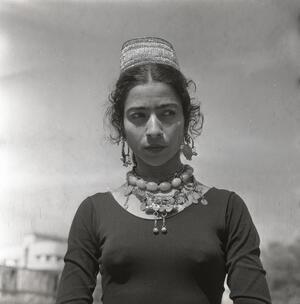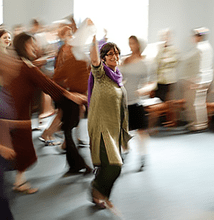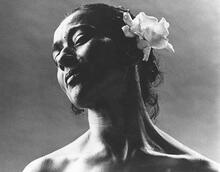Margalit Oved
Margalit Oved in a 1960 promotional picture for the Inbal Dance Company.
Courtesy of the Israeli National Photo Collection/Wikimedia Commons.
Dancer and choreographer Margalit Oved’s performances blended elements from the Yemen of her childhood, the Israel of her adolescence, and the Los Angeles of her adulthood. Oved began her career in her teens, as a founding member of Tel Aviv’s Inbal Dance Company. For fifteen years, she danced and choreographed for the troupe. In 1967 she settled in Los Angeles and began teaching dance at UCLA while crafting solo works and creating the Margalit Oved Dance Theater Company. Her work often incorporated both biblical and autobiographical themes and achieved popularity at the 1972 Los Angeles Dance Festival. In 1994 she returned to Israel to revive the Inbal Dance Company and began working as a singer and musical director for her son Barack Marshall’s dance company.
Margalit Oved—dancer, choreographer, singer, actress, musician—is the epitome of a performance artist. She has left an indelible mark on twentieth-century Jewish culture through her inventive and modern interpretations of ancient biblical tales.
Early Life and work in Israel
Oved, an émigré from Yemen began her career in her teens as one of the original members of Sarah Levi-Tanai’s Inbal Dance Company in Tel Aviv, Israel. Her creative roots go further back, however, to her native Aden, where as a child she danced barefoot and carefree. Her story told through her dances is that of a Jewish Yemenite turned Israeli and then American. Despite her several transformations, she did not abandon her earliest influences. At the same time, she has internalized her experiences in the United States, including the raising of an American-born family, and used them to inform her more recent work.
Born around 1934, Oved attended Catholic school because her mother believed that she would receive the best education there. In an interview with The Jerusalem Post in 1995, Oved said that her mother’s concept of God was “sincerity, compassion, and honesty.”
In her fifteen years with the Inbal Dance Company, Oved choreographed dances based on the rhythms and traditions of Yemen, Arabia, Africa, India, and Spain. She worked closely with Inbal’s students, as well as with its director, Sarah Levi-Tanai. Oved rose to the status of principal dancer before quitting the company in 1965 to strike out on her own.
Work in Los Angeles
In 1967, she settled in Los Angeles. She met and married Melvin Marshall, whom she has called a “prince of the Bronx.” Together, they have two sons.
Oved began teaching in the dance department at UCLA. She started building her solo repertoire, creating Yemenite Wedding, The Dybbuk of Aden, The Birth of a Drum, and Kingdom of Spirit. Other dances from that period include Gestures of Sand (made into a documentary film), A Donkey Stepped on a Flower, The Prophetess, Tamar, In Memory of Jeanie Irwin, A Dancer, and My Father (later renamed The Family of Man). Landscape brought her to the attention of the American public when it was performed at the Los Angeles Dance Festival in 1972. Dance Magazine wrote, “[Oved is] a radiant performer who moves with calculated economy yet conveys an impression of dancing with extravagant panache. Oved is also a highly original choreographer.”
In 1973, she created Through the Gate of Aden, the tale of her own life writ large. Through music and movement, she portrayed life in her native town.
Biblical, familial, and mystical themes occupy center stage in Oved’s work. Through these themes, she expresses her beliefs about life’s basic virtues and values: honesty, simplicity, and the importance of human relationships. For example, her work In the Beginning enacts the burgeoning awareness of Adam and Eve. Dance Magazine, in September 1974, described the work as portraying “the discovery of all expression for the first time ... the journey from the paradise of non-knowledge to the hell of knowledge.”
Another work, David and Goliath, portrays the saga of the Israelite shepherd who slew the giant Philistine. Oved, dancing both roles, created a play on the multiple facets of the two characters and how they interacted with one another. By incorporating elements of the slain Goliath, through his gestures and facial expressions, into the triumphant David, she depicted the evolution of the youthful shepherd into a powerful monarch.
Oved created her own music for most of her dances, relying heavily on percussion instruments. These instruments, she feels, mimic the sounds of her childhood when she played with tin cans given to her by her mother. Oved also learned how to use her own voice as another instrument. One of her performance signatures was the combination of taped voice and instrumentation serving as background music for live singing. Through song and percussion, she sought to reflect the totality of human and animal sound. She told Dance Magazine in 1974, “It is the climate, philosophy, human concerns, birth, death, and above all, feeling.”
During her nearly thirty years in Los Angeles, Oved formed her own company, the Margalit Dance Theatre Company. Besides dancing and choreographing, she acted in such films as The Greatest Story Ever Told (1965) and Hill 24 Doesn’t Answer (1955).
Honors and Awards
Oved’s professional accomplishments have been recognized with three choreography awards from the National Endowment for the Arts. Hadassah, the Women’s Zionist Organization, honored her for her contributions to Jewish culture with its prestigious Myrtle Wreath Award in 1973. In 1994, she returned to Tel Aviv to revitalize the Inbal Dance Company, accompanied by her twenty-six-year-old son Barak Marshall, a prominent Israeli choreographer and director of his own dance company, for which his mother acts as music director and often, principal singer. Oved played the lead vocal role in Marshall’s first choreographical works, the award-winning productions Aunt Leah (1995) and Emma Goldman’s Wedding (1997). “Margalit has the emotional power of a giant,” wrote the New York Times reviewer, and another wrote that “Barak Marshall’s choreography is the result of an important working relationship with his mother, Margalit Oved, whose presence on stage is overwhelming.” These shows, along with another Barak choreography, “Shoshana’s Balcony” (created in 1999) continue to be presented to wide acclaim at venues throughout Europe, featuring Oved as the principal singer.
Attitude 1, no. 4 (August/September 1982): 4.
“Aunt Leah/Emma Goldman’s Wedding.” Biennale de la danse de Lyon, 1998.
Dance Magazine (August 1972): 25–26, and (September 1974): 44–46.
The Jerusalem Post, October 25, 1994, and May 15, 1995, and June 12, 1995, and February 16, 1996.
Oved, Margalit. Program notes. Margalit Dance Theatre Company, Los Angeles, October 31, 1975–November 2, 1975.











